Abstract
In this paper, Lie symmetry analysis is presented for the (3 + 1)-dimensional BKP-Boussinesq equation, which seriously affects the dispersion relation and the phase shift. To start with, we derive the Lie point symmetry and construct the optimal system of one-dimensional subalgebras. Moreover, according to the optimal system, similarity reductions are investigated and we obtain exact solutions of reduced equations by means of the Tanh method. In the end, we establish conservation laws using Ibragimov’s approach.
1. Introduction
In the past few years, nonlinear evolution equations have been used to explore physical phenomena, such as marine engineering, plasma physics, fluid dynamics, etc. In order to understand many complex physical phenomena better, we need to research explicit solutions of nonlinear evolution equations. Wazwaz [] proposed the (3 + 1)-dimensional generalized BKP equation
which explains evolution of quasi-one dimensional shallow water waves when the effects of viscosity and surface tension are taken to be negligible []. Recently, a host of exact solutions of Equation (1), including grammian-type determinant solutions [], periodic wave solutions [], lump solutions [] and multiple wave solutions [], have been discussed. Moreover, adding an extra term , Wazwaz and El-Tantawy got an expansion of Equation (1), that is a new form of the (3 + 1)-dimensional BKP-Boussinesq Equation []
where is an unknown function and subscripts denote the partial derivatives. This equation possesses the properties of both the Boussinesq and the BKP equations, which can be used to describe the propagation of long waves in shallow water []. By using analysis of the Painlevé property, the integrability properties of Equation (2) have been proved []. One and two soliton solutions were derived by utilizing the simplified Hirota’s method in []. It was reported that coefficients of spatial variables were left as free parameters. Based on the Bäcklund transformation, the rational solutions and exponential wave solutions of Equation (2) were obtained in [].
Quite a few methods have been researched to find crucially exact solutions for nonlinear partial differential equations (PDEs). Some of the most remarkable methods are the Hirota bilinear method [], the homogeneous balance method [], the Sine–Gordon expansion method [], the Darboux transformation [], the -expansion method [,], Lie symmetry analysis [,,,], the inverse scattering method [], etc. Lie symmetry analysis, a very powerful method among those listed above, plays a significant role in obtaining exact solutions of PDEs. The basic idea of this method is to keep the solution set of the partial differential equations invariant under infinitesimal transformation. Using the symmetry method, we construct the optimal system of Equation (2), from which some interesting exact solutions are obtained by using the classical Tanh method [,]. Another important aspect is conservation laws of PDEs which have important influence on finding solutions of PDEs [,]. We will construct the conservation laws of Equation (2) by applying Ibragimov’s approach [].
Eventually, the framework of this paper is as follows. In Section 2, we derive the Lie point symmetry of the (3 + 1)-dimensional BKP-Boussinesq equation. In Section 3, the optimal system of Equation (2) is constructed. We handle similarity reductions and obtain the reduced equations in Section 4. In Section 5, exact solutions of the reduced equations are presented by means of the Tanh method. Based on lbragimov’s method, we build the conservation laws in Section 6. The last section is made up of some brief statements.
2. Lie Point Symmetry
In this section, carrying out the Lie symmetry analysis method for Equation (2), we consider a one-parameter Lie group transformation
with a small parameter . The infinitesimal generator linked with the above group transformation is given as
and its fourth-order prolongation is
where
and , respectively, represent the total derivatives concerning and z. Then, the determining equations generated by the invariance conditions can be written as
where . Furthermore, we obtain the following system of overdetermined equations
Solving this system, we can get
where are arbitrary constants and and are arbitrary functions. To obtain physically crucial solutions, we take , then substituting the above and obtaining
where and are arbitrary constants. Thus seven-dimensional Lie algebra made up of infinitesimal symmetries is spanned by the following generators
After getting the infinitesimal generators, the following group transformations, which are formed by the for can be given as
where is any real number. We discover that is a scalar transformation, is a z -translation, is a t -translation, is a y -translation, is an x -translation, and are Galilean transformations.
3. The Optimal System of One-Dimensional Subalgebras
It is impractical for us to list all possible group-invariant solutions. Consequently, we need an effective and systematic way to classify these solutions; after doing this we form an optimal system of group-invariant solutions. Ibragimov et al. introduced a succinct method that relies only on the commutator table [] to obtain the optimal system of one-dimensional subalgebras. The commutation relations about Lie algebra determined by are given in Table 1. Evidently, is closed under the Lie bracket.

Table 1.
Table of Lie brackets.
An arbitrary operator is expressed as
In order to find the linear transformations about the vector , we have the following generator
where is given as the formula . Based on Equation (4) and Table 1, are written as
With regard to the generators and , the Lie equations that have parameters and with the initial condition can be given as
Then, we present the following transformations of the solutions of these equations
The structure of the optimal system demands simplification of the vector
via the transformations . We are absorbed in seeking the simplest representative of each class of the similar vectors of Equation (5). The structure is classified into two cases.
Case 3.1
We take in the transformation , causing . As a result, Vector (5) is simplified as follows
Moreover, taking in the transformation , in the transformation , in the transformation , in the transformation , and in the transformation , we reduce Vector (6) to the form
In consequence, considering all the possible combinations, we derive the following representative
Case 3.2
We consider Vector (5) of the form
3.2.1
We take in the transformation , causing . Therefore, Vector (8) is simplified as follows
Taking all the possible combinations, we derive the following representatives
3.2.2
We consider Vector (8) of the form
Taking all the possible combinations, we derive the following representatives
Ultimately, by collecting Operators (7), (9) and (10), we reach the following theorem:
Theorem 1.
An optimal system of subalgebras of seven-dimensional Lie algebras of Equation (2) is offered in the following operators:
4. Similarity Reductions of the BKP-Boussinesq Equation
In the preceding sections, we studied Lie symmetry analysis and constructed the optimal system of Equation (2). Next, we cope with the similarity reductions and obtain the reduced equations.
Case 4.1
For the generator , we have similarity variables
and the group invariant solution is written as
Substituting Equation (11) into Equation (2), we obtain the following reduced equation
Case 4.2
For generator , we have similarity variables where . Substituting them into Equation (2) enables f to satisfy the following reduced equation
Case 4.3
For generator , we have . The reduced equation is given as follows
Case 4.4
For generator , we have . Substituting them into Equation (2) enables f to satisfy the following reduced equation
Case 4.5
For generator , we have in which . Substituting them into Equation (2) causes f to satisfy the following reduced equation
Case 4.6
For generator , we have . By substituting them into Equation (2), we have the following reduced equation
Case 4.7
For generator , we have where . By substituting them into Equation (2), the following reduced equation is expressed as follows
Case 4.8
For generator , we have . By substituting them into Equation (2), we obtain the following reduced equation
Case 4.9
For generator , we have . The form of the reduced equation is
Case 4.10
For generator , we obtain . The corresponding reduced equation is
5. The Explicit Solutions of Reduced Equations
In the previous section, we have dealt with the similarity reductions and derived the corresponding reduced equations. In this section, we perform the Tanh method on reduced equations and obtain exact solutions of Equation (2). With the help of exact solutions, we can clearly understand the properties and applications of the (3 + 1)-dimensional BKP-Boussinesq equation. Here, we consider Equations (12)–(16); the others can be obtained in the same way.
5.1. Description of the Tanh Method
The main steps of the Tanh method [,] are expressed as follows:
- Consider a general form of nonlinear partial differential equationwhere F is a polynomial of the u and its derivatives.
- Next, we introduce an independent variablewhich has the following changes
- We assume that the solution of Equation (24) is written in the following formwhere k is an integer, which is determined by balancing the highest order derivative terms with the nonlinear terms in the resulting equation. After determining k, putting Equations (26) and (27) into Equation (24), we get a polynomial concerning . Then we collect all terms of and make each of them equal to zero, which obtaina the algebraic equations containing unknown numbers and c. Solving these equations, we get the values of unknowns. Finally, plugging these values into equations, we derive exact solutions of equations.
5.2. Exact Solution of Equation (12)
For Equation (12), substituting Equation (23) into Equation (12), we obtain the following ordinary differential equation
Concerning Equation (28), balancing with , we have
Then, substituting Equations (26) and (29) into Equation (28), we collect all terms of and obtain the algebraic equations including unknown numbers and c. By solving these equations, we have the following solutions
Putting Equation (30) into Equation (12), we obtain the exact solution of Equation (12) as follows
where , and l are arbitrary constants. By using similarity variables and the group invariant solution we obtain the exact solution of Equation (2) as follows
where , and l are arbitrary constants.
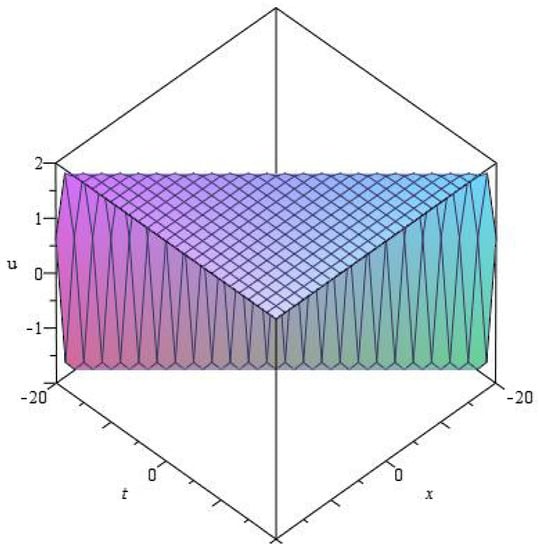
Figure 1.
for at .
5.3. Exact Solution of Equation (13)
Similarly, substituting Equation (23) into Equation (13), we have the following ordinary differential equation
Then, balancing with for (32), we have .
Next, substituting Equation (26) and Equation (33) into Equation (32), we make all coefficients of vanish and obtain the algebraic equations including unknown numbers and c. Solving these equations, we have the following solutions
When we take at , the value of u is as illustrated in Figure 2 below.
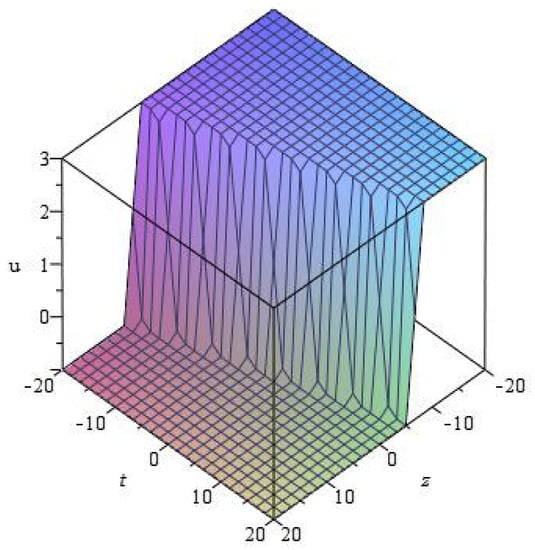
Figure 2.
for at .
5.4. Exact Solution of Equation (14)
Equally, substituting Equation (23) into Equation (14), we get the following ordinary differential equation
Furthermore, balancing with for (34), we have .
Next, substituting Equation (26) and Equation (35) into Equation (34), we make all coefficients of vanish and obtain the algebraic equations including unknown numbers and n. Solving these equations, we have the following solutions
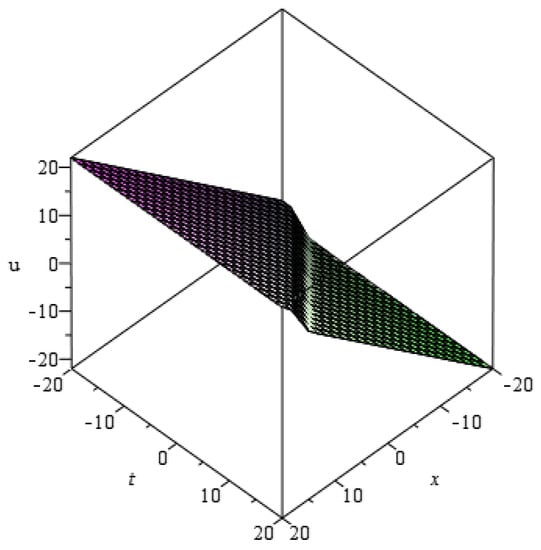
Figure 3.
for at .
5.5. Exact Solution of Equation (15)
In the same way, substituting Equation (23) into Equation (15), we have the following ordinary differential equation
Then, balancing with for (36), we have .
Next, substituting Equations (26) and (37) into Equation (36), we make all coefficients of vanish and obtain the algebraic equations including unknown numbers and c. Solving these equations, we have the following solutions
So, the exact solution of Equation (2) is
where , and n are arbitrary constants.
When we take at , the value of u is illustrated in Figure 4 below.
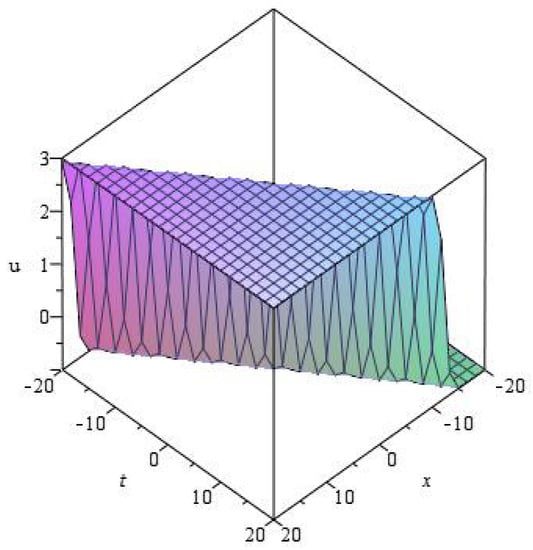
Figure 4.
for at .
5.6. Exact Solution of Equation (16)
Likewise, substituting Equation (23) into Equation (16), we get the following ordinary differential equation
Then, balancing with for Equation (38), we have .
Next, substituting Equations (26) and (39) into Equation (38), we make all coefficients of vanish and obtain the algebraic equations including unknown numbers and n. Solving these equations, we have the following solutions
So, exact solution of Equation (2) is
where , and l are arbitrary constants.
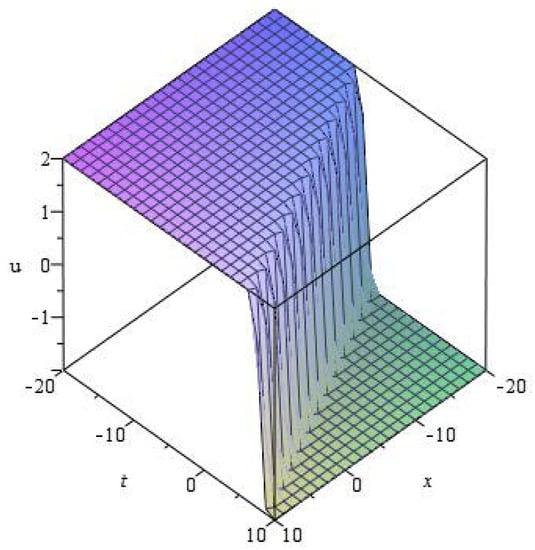
Figure 5.
for at .
6. Construction of Conservation Laws
In this section, we chiefly construct conservation laws of Equation (2) using Ibragimov’s method [,]. First, we prove that Equation (2) is nonlinear self-adjoint.
6.1. Nonlinear Self-Adjointness of Equation (2)
With regard to Equation (2), the conservation law multiplier [] has the following form
Moreover,
where the Euler operator is expressed as
Substituting Equation (41) into Equation (40), equating the coefficients of the various monomials in the first, second, and the other order partial derivatives and various powers of u, we obtain a system which only has an unknown variable ,
Solving this system, we have , where and are arbitrary functions.
Consider a PDE system of order m
where , and represent the set of all first, second, …, kth-order derivatives of u in regards to x.
The adjoint equations of Equation (42) are written as
Besides,
where is a formal Lagrangian of the following form
and the Euler–Lagrange operator is expressed as
Definition 1
([]). System (42) is said to be nonlinearly self-adjoint if the adjoint system is satisfied for all the solutions u of System (42) upon a substitution such that . In particular, the system
is identical to the system
that is
where is a certain function.
Theorem 2
([]). The determining system of the multiplier of System (42) is identical to the system of nonlinearly self-adjoint substitution.
6.2. Construction of Conservation Laws
Theorem 3
([]). The system of differential Equation (42) is nonlinearly self-adjoint, so every Lie point, Lie-Bäcklund, nonlocal symmetry
admitted by the system of Equation (42) gives rise to a conservation law, where the components of the conserved vector are determined by
and . The formal Lagrangian should be written in the symmetric form concerning all mixed derivatives
The Lagrangian is given as follows
For the generator in line with the Theorem 3, we obtain , so the components of the conservation vector have the following form
By substituting the Lagrangian into above components of the conservation vector, are simplified as
For generator , we have . According to Equations (44)–(47), the components of the conserved vector of generator have the following form
For generator , we have . According to Equations (44)–(47), the components of the conserved vector of generator can be expressed as follows
For generator , we have . According to Equations (44)–(47), the components of the conserved vector of generator can be written in the following form
For generator , we have . According to Equations (44)–(47), the components of the conserved vector of generator are given as
For generator , we have . According to Equations (44)–(47), the components of the conserved vector of the generator can be expressed as
For generator , we have . According to Equations (44)–(47), the components of the conserved vector about the generator can be written as
For generator , we have . According to the formulas (44)–(47), the components of the conserved vector concerning the generator are written as
7. Conclusions
In this paper, the Lie symmetry analysis method is applied to the (3 + 1)-dimensional BKP-Boussinesq equation. Based on this method, we construct the optimal system of one-dimensional subalgebras. Furthermore, some similarity reductions are handled and exact solutions of the reduced equations are obtained by means of the Tanh method. Finally, it is shown that Equation (2) is nonlinearly self-adjoint. Meanwhile, using Ibragimov’s method, we derive the conservation laws widely used in the field of mathematical physics. After obtaining the exact solutions of Equation (2), we can depict the propagation of long waves in shallow water better and know more applications in the physical field, such as the percolation of water in porous subsurfaces of a horizontal layer of material.
Author Contributions
Conceptualization, methodology, formal analysis, mathematical modeling, writing—review and editing, B.G.; software, investigation, Y.Z. All authors have read and agreed to the published version of the manuscript.
Funding
This research is sponsored by the Scientific and Technological Innovation Programs of Higher Education Institutions in Shanxi (No. 2017116) and the Natural Science Foundation of Shanxi (No. 201801D121018).
Acknowledgments
The authors are grateful to the unknown reviewers and the academic editor for their very useful comments.
Conflicts of Interest
The authors declare no conflict of interest.
References
- Wazwaz, A.M. Two B-type Kadomtsev-Petviashvili equations of (2 + 1) and (3 + 1) dimensions: Multiple soliton solutions, rational solutions and periodic solutions. Comput. Fluids 2013, 86, 357–362. [Google Scholar] [CrossRef]
- Verma, P.; Kaur, L. Integrability, bilinearization and analytic study of new form of (3 + 1)-dimensional B-type Kadomstev–Petviashvili (BKP)-Boussinesq equation. Appl. Math. Comput. 2019, 346, 879–886. [Google Scholar] [CrossRef]
- Cheng, L.; Zhang, Y. Grammian-type determinant solutions to generalized KP and BKP equations. Comput. Math. Appl. 2017, 74, 727–735. [Google Scholar] [CrossRef]
- Tu, J.M.; Tian, S.F.; Xu, M.J.; Ma, P.L.; Zhang, T.T. On periodic wave solutions with asymptotic behaviors to a (3 + 1)-dimensional generalized B-type Kadomtsev-Petviashvili equation in fluid dynamics. Comput. Math. Appl. 2016, 72, 2486–2504. [Google Scholar] [CrossRef]
- Yang, J.Y.; Ma, W.X. Lump solutions to the BKP equation by symbolic computation. Int. J. Modern Phys. B 2016, 30, 1–7. [Google Scholar] [CrossRef]
- Ma, W.X.; Zhu, Z. Solving the (3 + 1)-dimensional generalized KP and BKP equations by the multiple exp-function algorithm. Appl. Math. Comput. 2012, 218, 11871–11879. [Google Scholar] [CrossRef]
- Wazwaz, A.M.; Tantawy, S.A.E. Solving the (3 + 1)-dimensional KP-boussinesq and BKP-boussinesq equations by the simplified hirotas method. Nonlinear Dyn. 2017, 88, 3017–3021. [Google Scholar] [CrossRef]
- Yan, X.W.; Tian, S.F.; Dong, M.J.; Zou, L. Bäcklund transformation, rogue wave solutions and interaction phenomena for a (3 + 1)-dimensional B-type Kadomtsev-Petviashvili-Boussinesq equation. Nonlinear Dyn. 2018, 92, 709–720. [Google Scholar] [CrossRef]
- Hirota, R. Exact solutions of the Sine-Gordon equation for multiple collisions of solitons. J. Phys. Soc. Jpn. 1972, 33, 1459–1463. [Google Scholar] [CrossRef]
- Fan, E.; Zhang, H.Q. A note on the homogeneous balance method. Phys. Lett. A 1998, 246, 403–406. [Google Scholar] [CrossRef]
- Baskonus, H.M.; Bulut, H.; Sulaiman, T.A. New Complex Hyperbolic Structures to the Lonngren-Wave Equation by Using Sine-Gordon Expansion Method. Appl. Math. Nonlinear Sci. 2019, 4, 129–138. [Google Scholar] [CrossRef]
- Imai, K. Generlization of Kaup-Newell inverse scattering formulation and Darboux transformation. J. Phys. Soc. 1999, 68, 355–359. [Google Scholar] [CrossRef]
- Wang, M.L.; Li, X.Z.; Zhang, J.L. The (G′/G)-expansion method and travelling wave solutions of nonlinear evolution equations in mathematical physics. Phys. Lett. A 2008, 372, 417–423. [Google Scholar] [CrossRef]
- Khalique, C.M.; Mhlanga, I.E. Travelling waves and conservation laws of a (2 + 1)-dimensional coupling system with Korteweg-de Vries equation. Appl. Math. Nonlinear Sci. 2018, 3, 241–254. [Google Scholar] [CrossRef]
- Hydon, P.E. Symmetry Methods for Differential Equations; Cambridge University Press: Cambridge, UK, 2000. [Google Scholar]
- Sophus, L. Theories der Tranformationgruppen, Dritter and Letzter Abschnitt; Teubner: Leipzig/Berlin, Germany, 1888. [Google Scholar]
- Olver, P.J. Applications of Lie Groups to Differential Equations; Springer: Heidelberg, Germany, 1986. [Google Scholar]
- Ovsiannikov, L.V. Group Analysis of Differential Equations; Academic Press: New York, NY, USA, 1982. [Google Scholar]
- Boiti, M.; Leon, J.J.; Manna, M.; Pempinelli, F. On the spectral transform of a Korteweg-de Vries equation in two spatial dimensions. Inverse Probl. 1986, 2, 271–279. [Google Scholar] [CrossRef]
- Wazwaz, A.M. The Tanh method: solitons and periodic solutions for the Dodd-Bullough-Mikhailov and the Tzitzeica-Dodd-Bullough equations. Chaos Solitons Fractals. 2015, 25, 55–63. [Google Scholar] [CrossRef]
- Malfliet, W. Solitary wave solutions of nonlinear wave equations. Am. J. Phys. 1992, 60, 650–654. [Google Scholar] [CrossRef]
- Gao, B.; Wang, Y.X. Invariant Solutions and Nonlinear Self-Adjointness of the Two-Component Chaplygin Gas Equation. Discret. Dyn. Nat. Soc. 2019, 2019, 9609357. [Google Scholar] [CrossRef]
- Silva, V.A. Lie point symmetries and conservation laws for a class of BBM-KdV systems. Commun. Nonlinear Sci. Numer. Simul. 2019, 69, 73–77. [Google Scholar] [CrossRef]
- Ibragimov, N.H. A new conservation theorem. J. Math. Anal. Appl. 2007, 333, 311–328. [Google Scholar] [CrossRef]
- Grigoriev, Y.N.; Ibragimov, N.H.; Kovalev, V.F.; Meleshko, S.V. Symmmetry of Integro-Differential Equations: With Applications in Mechanics and Plasma Physica; Springer: Berlin, Germany, 2010. [Google Scholar]
- Ibragimov, N.H. Integrating factors, adjoint equations and Lagrangians. J. Math. Anal. Appl. 2006, 318, 742–757. [Google Scholar] [CrossRef]
- Bluman, G.W.; Cheviakov, A.; Anco, S. Applications of Symmetry Methods to Partial Differential Equations; Springer: Berlin, Germany, 2010. [Google Scholar]
- Ibragimov, N.H. Nonlinear self-adjointness and conservation laws. J. Phys. A 2011, 44, 432002. [Google Scholar] [CrossRef]
- Ibragimov, N.H. Nonlinear self-adjointness in constructing conservation laws. Arch. ALGA 2011, 7, 1–99. [Google Scholar]
© 2020 by the authors. Licensee MDPI, Basel, Switzerland. This article is an open access article distributed under the terms and conditions of the Creative Commons Attribution (CC BY) license (http://creativecommons.org/licenses/by/4.0/).